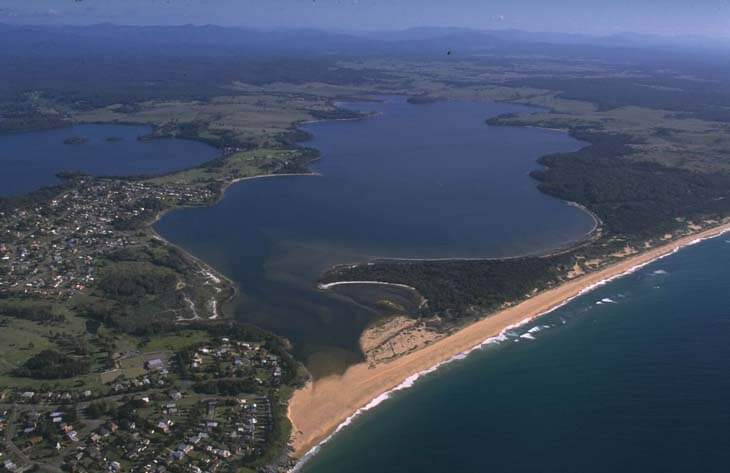Coila Lake is a large shallow estuary located north of the Tuross River on the south coast of New South Wales. It is classed as a lake with an intermittently closed entrance. The catchment area for Coila Lake is relatively small and the estuary entrance is predominantly closed.
Coila Lake is an important commercial fishing area, being one of 5 major estuaries on the South Coast open for catch of crustaceans and finfish. The estuary supports a large prawn fishing industry.
Water quality report card
As part of our water quality monitoring program we assess the water quality and ecosystem health of an estuary using a range of relevant indicators. We sample a subset of the estuaries between Wollongong and the Victorian border every 3 years. The most recent sampling in Coila Lake was completed over the 2020–21 summer, when 2 sites were sampled on a monthly basis.
This report card represents 2 water quality indicators that we routinely measure: the amount of algae present and water clarity. Low levels of these 2 indicators equate with good water quality.
Algae
Water clarity
Overall grade
The report card shows the condition of the estuary was fair with:
- algae abundance graded poor (D)
- water clarity graded good (B)
- overall estuary health graded fair (C).
Grades for algae, water clarity and overall are represented as:
- A – excellent
- B – good
- C – fair
- D – poor
- E – very poor.
Go to estuary report cards to find out what each grade means, read our sampling, data analysis and reporting protocols, and find out how we calculate these grades.
Eurobodalla Shire Council has a long-term water quality monitoring program in Coila Lake, based on the same sampling and reporting methods as our statewide program. The results of the monitoring program, including a detailed water quality report card, are available on the Eurobodalla Shire Council website.
We have monitored water quality in Coila Lake since 2007. This table shows the water quality grades for this estuary over that time.
| Year | Algae | Water clarity | Overall grade |
|---|---|---|---|
| 2007–08 | B | A | A |
| 2008–09 | A | A | A |
| 2017–18 | C | B | C |
Physical characteristics
| Estuary type | Lake |
|---|---|
| Latitude | –36.5 (ºS) |
| Longitude | 150.14 (ºE) |
| Catchment area | 47.6 km2 |
| Estuary area | 7.1 km2 |
| Estuary volume | 15,441.6 ML |
| Average depth | 2.3 m |
Notes: km2 = square kilometres; m = metres; ML = megalitres.
Water depth and survey data
Bathymetric and coastal topography data for this estuary are available in our data portal.
Land use
The catchment of Coila Lake has relatively low disturbance, with over 60% forest, including small areas in Eurobodalla and Deua national parks. Over 15% of the catchment is used for grazing and 5% is used for urban development in Coila, Turlinjah and Tuross Heads.
National and marine parks
- The catchment area for the Coila Lake catchment includes parts of the Eurobodalla National Park and the Deua National Park.
- Eurobodalla National Park is the largest conservation area in the Coila Lake catchment.
- This estuary flows into the Batemans Marine Park.
Citizen science projects
- iNaturalist’s Plants of Eurobodalla is a citizen science project that monitors plants found in the Eurobodalla region.
Community involvement
- Eurobodalla Landcare is a volunteer network of 24 Landcare groups on the NSW south coast.
- The Coastwatchers Association is a community environmental and conservation group based on the south coast.

Aerial view of Coila Lake
Local government management
Local councils manage estuaries within their area unless the estuary is attached to a marine park.
Eurobodalla Shire Council manages this estuary, which is located in Batemans Marine Park.
Threatened species
Coila Lake catchment provides habitat for an endangered population of greater gliders.
Read more about the biodiversity in our estuaries.